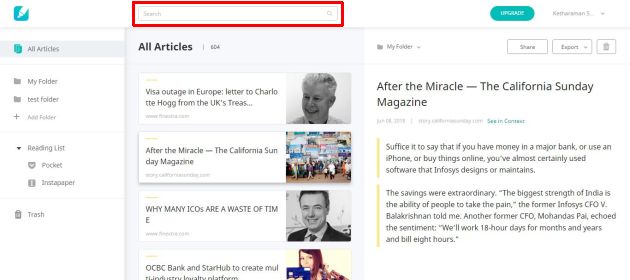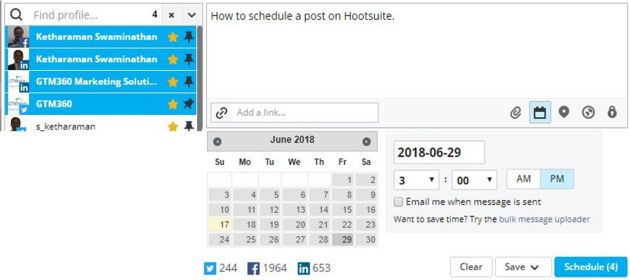In Part 1 of this blog post, we’d seen three best practices for converting Freemium to Premium viz. Ask For Money, Create Pinch Points, and Drive Enhanced Usage.
In this second part, I’ll cover three more best practices for SAAS vendors to upgrade their freemium users to paying customers.
#4. INTRODUCE VALUE ADDED FEATURES
You can package one or two extensions of your freemium product as value added features. By charging a nominal fee for them, you’d be able to monetize your product. This is similar to the tactic used by videogames to make money by selling virtual goods e.g. magic potion that bestows extra strength to the player.
Liner is a good example of a SAAS company that uses this technique. Its free product lets users highlight portions of a webpage, get a link, view all their highlights in a single dashboard, and so on.
Content marketing professionals among other power users will find themselves collecting a lot of highlights very soon (I have 650 highlights now). At that point, they’d start craving for a way to search through their past highlights. Enter Liner’s Search. Priced nominally, the add-on helps you retrieve and reuse your past content. I found Liner Search so compelling that I bought it within a few days of onboarding Liner.
I’ve found similar value added features in FlightRadarPro (aeronautical charts), WordPress (VIP), et al.
FlightRadarPro is the poster child for freemium model: I went from the free app to its paid version in < 10 minutes.
— Ketharaman Swaminathan (@s_ketharaman) September 10, 2013
And eagerly look forward to finding them in other products like Disqus.
Wish @disqus had a search feature à la @getliner . Over the years I've left 1350 comments on the world's most popular commenting platform. By now, it has become very painful and time consuming to browse through them manually to find my past comments that are suitable for reuse.
— GTM360 (@GTM360) June 17, 2018
#5. MAKE IT EASY TO UPGRADE
This point should be obvious but it deserves stating because there are still many companies who don’t get it.
I recently wanted to watch the Portugal v. Spain football match at the ongoing World Cup. Because the only TV in my house was not available at the time, I headed over to SonyLIV, the licensed provider of live streams for FIFA World Cup 2018. The website offered a five-minute delayed stream for free (“freemium”) and the live stream for a fee (“premium”). I first checked out the freemium version. After watching it for a few minutes, I was reasonably happy with the streaming quality. I then decided to upgrade to the premium version.

What followed was a very painful experience.
The site didn’t allow purchase in guest mode. The registration form asked for too much information like gender, date of birth, zip code, etc. On top of that, it had a reCAPTCHA that was terribly hard to decipher.
Somehow, I managed to crack it and clicked the DONE button at the end of the page. Nothing happened. I tried a few more times. Then I got an error message saying the reCAPTCHA had expired. I was told to crack another reCAPTCHA.
Normally, I’d have bailed out of the website at this stage. On this instance, I went ahead only because of my love of soccer.
After cracking the second reCAPTCHA, I reached the checkout page. The price was garbled. I saw multiple payment options. I selected PayZapp and clicked the PROCEED TO PAY button. On the next screen, I was expecting to enter my PayZapp PIN number. Instead, I saw a repeat of all modes of payment – except PayZapp.
Duh?
Once again, driven by my passion for the game, I went ahead.
I selected credit card and hit the PAY button. Nothing happened.
Friction finally overcame passion and I abandoned my attempt to upgrade to SonyLIV’s premium version.
While Sony’s is the most egregious example of a company that makes it difficult to upgrade to its premium version, it’s by no means the only one. When I point out the friction in their purchase journey, many companies uniformly reply “security”. While security is not to be taken lightly, half of these guys have a wrong notion of security and the other half needs to realize that security doesn’t pay their bills. Besides, when was the last time you had to enter your DOB or crack a reCAPTCHA while buying something from the Amazons, Cleartrips and Ubers of the world?
UPDATE DATED 5 JULY 2018:
I gave it one more shot and, on this occasion, I was able to complete my upgrade successfully. On the previous occasions that I faced problems, I remember the website listing 6-7 payment methods e.g. Credit Card / Debit Card, PayTM, UPI, PayZapp, etc. On this occasion, I saw only the first two options. My preferred option, PayZapp, was missing. I guess there was something wrong with the PayZapp payment gateway and after removing it, the website started behaving properly.
#6. OUTPLACE
While trying to upgrade your freemium users to your paid version, you will lose some of your users. That’s an inevitable consequence of the fact that some people are time rich and money poor, and will always look around for free alternatives.
Back in the day, SAAS companies tried to lock-in their customers by storing their data in non-portable proprietary formats. In today’s world of social media-amplified outrage, such sharp practices could tarnish a company’s reputation in no time. Besides, even SAAS giants are now letting their users export their data to industry standard formats like CSV. So smaller players can’t afford to be politically incorrect.
Good news is, there are many perfectly fair ways to minimize churn during the transition from freemium to premium. They include attractive upgrade offers, freemium backdoor and other techniques described in my blog post entitled Five Ways To Win Back Lost SaaS Customers.
After doing all this, if you’re still left with any residual leavers, you can outplace them to vendors of similar products in return for a referral fee. In the past, this was a practice followed only by companies that were shutting down but, nowadays, even going concerns are increasingly resorting to this tactic while shedding their freemium users.
In this two-part blog post, we’ve seen six tactics for converting freemium users to paying customers.
At first blush, some of them might appear unethical. On deeper analysis, you might realize that there’s nothing really unethical about them. You will finally get past the ethics dilemma after finding out that these tactics are used by a number of large and reputed companies. At the next stage, you would realize that some of these best practices yield onetime fees whereas others can generate recurring revenues; some of them might be easy to implement in your product whereas others might be hard; and so on.
Ergo, there’s no one size that fits all companies.
Each SAAS provider will want to work out the approach that optimizes revenue, ease of execution and adherence to moral compass in its specific context. If you need help with that, we’re always there.


